Hummingbirds are so exciting to watch because they’re so unique. They have beautiful, bright colors and they zoom and swoop so charmingly through the air. Plus, many of them willingly visit backyard feeders.
Hummingbirds have their natural native ranges, but most of these birds are wanderers. They’ll travel far away searching for food.
While the ruby-throated hummingbird is the most common and the only nesting type in Michigan, you can also see many other beautiful species, known as vagrant or accidental species, that visit rarely. Hummingbirds mostly stick to warmer climates but they’ll brave colder ones for a good source of food.
Hummingbirds are a New World group of birds, meaning they only live in South, Central, and North America. Within North America, there are 16 native species of hummingbirds and a few visiting species. Of those, just one is common in Michigan, while eight others will rarely visit.
Here is the list of species of hummingbirds in Michigan:
- Ruby Throated Hummingbird
- Anna’s Hummingbird
- Calliope Hummingbird
- Rufous Hummingbird
- Mexican Violetear
- Broad-Billed Hummingbird
- Costa’s Hummingbird
- White Eared Hummingbird
- Berylline Hummingbird
9 Types of Hummingbirds in Michigan
Hummingbirds visit every part of North America, but Michigan is lucky enough to have five vagrant species that pop in once in a while. Here are the six species you might see:
1. Ruby Throated Hummingbird
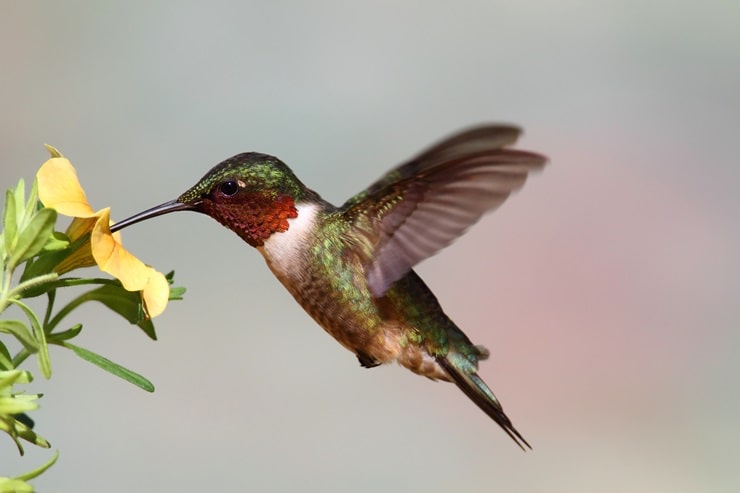
- Scientific name: Archilochus colubris
- Size: 2.8-3.5 inches long
- Weight: 0.1-.02 ounces
- Wingspan: 3.1-4.3 inches
Say “hello” to the most common – by far – hummingbird in all of Michigan. In fact, this is the only breeding hummingbird in the eastern part of North America, and the only non-migratory hummingbird in the state.
The male birds are easy to identify by their bright red throats. If you notice a bird that looks somewhat like a ruby-throated, but the throat looks dark red, it’s likely just because the feathers aren’t in good light. Wait until the sunlight hits them, and you’ll see that shining bright throat.
Otherwise, these birds are emerald or golden-green on their backs and grayish-white on the underside. The beaks are black.
These bold birds are frequent visitors to feeders and if you have the chance to watch their antics, take it. They are incredibly agile. They can stop instantly in the air, hover up, down, side-to-side, and backward. Not only do they feed at feeders and in tubular flowers, but they’ll snatch insects out of the air or from webs, as well.
These generalists live in parks, gardens, backyards, meadows, fields, forests, and woodlands.
They fly away in the fall to winter in Central America and they actually fly across the Gulf of Mexico in one single flight without stopping. Very impressive!
When Do They Arrive In and Leave Michigan?
Ruby-throated hummingbirds are the only non-migratory hummingbirds in Michigan. They prefer warmer regions, but they aren’t scared to hang out even in the colder months.
You can see them most often during the breeding season throughout Michigan, which takes place from March to July, but they might be found any time of year.
2. Anna’s Hummingbird
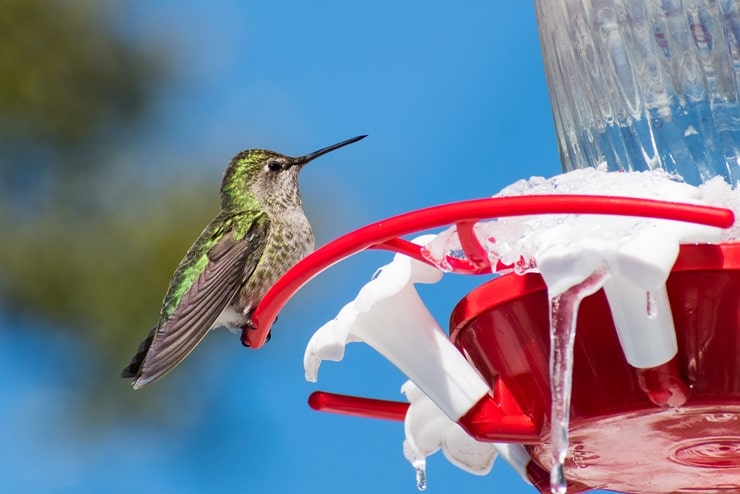
- Scientific name: Calypte anna
- Size: 3.9 inches long
- Weight: 0.1-0.2 ounces
- Wingspan: 4.7 inches
If you live along the Pacific coast, then no doubt you’ve seen the stunning Anna’s hummingbird. They’re one of the most common species in the region and they live there all year long. They’ll also travel inland a bit during the breeding season and some will migrate to Mexico during the non-breeding season.
Look for the greenish-gray birds with iridescent feathers. Males have reddish-pink chins and heads.
When they’re breeding, the males will swoop down up to 130 feet, making a buzzing noise with their tail feathers in an attempt to impress the females.
These birds are bold and curious and will come right up to humans to check them out. They’ll eat at feeders, snatch insects, and suck the sap of tubular flowers.
When Do They Arrive In and Leave Michigan?
If you live in Michigan, it’s summer when you might be able to spot them. They’re an accidental visitor and have only been seen a few times in Michigan.
3. Calliope Hummingbird
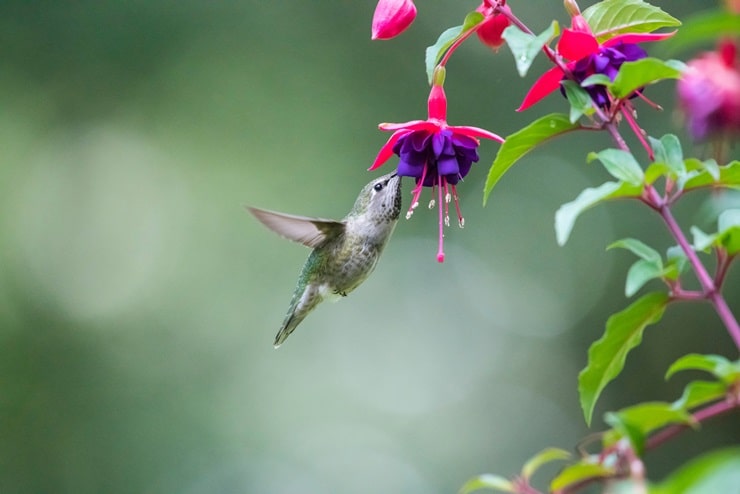
- Scientific name: Selasphorus calliope
- Size: 2.8-3.9 inches long
- Weight: 0.07-0.1 ounces
- Wingspan: 4.3 inches
Calliope hummingbirds are super uncommon in Michigan, but you might get lucky and see one of these non-natives visit any area of the state. If you do, make sure to brag to your friends! They’re far more common in the Pacific Northwest, California, parts of the west, and Canada.
They breed in western Canada, Oregon, Washington, California, Nevada, Idaho, Montana, Wyoming, and parts of Utah and they spend the non-breeding season in Mexico.
The males of these beautiful birds have magenta feathers on their throats and both females and males have iridescent green feathers on their backs. The male courts the female by diving in an acrobatic u-shape while making a buzzing sound with his tail feathers. They breed from April to June.
While they will eat from feeders, they tend to be a bit shyer than some other hummingbirds. They aren’t afraid of other birds, though. They’re even known to chase away red-tailed hawks.
They’ll eat the sap from flowers, but they’re also fond of the sap on trees left by sapsuckers and they’ll also eat insects and spiders.
When Do They Arrive In and Leave Michigan?
These tiny birds, the smallest hummingbirds in North America, might arrive in the summer before heading to their nesting territories.
4. Rufous Hummingbird
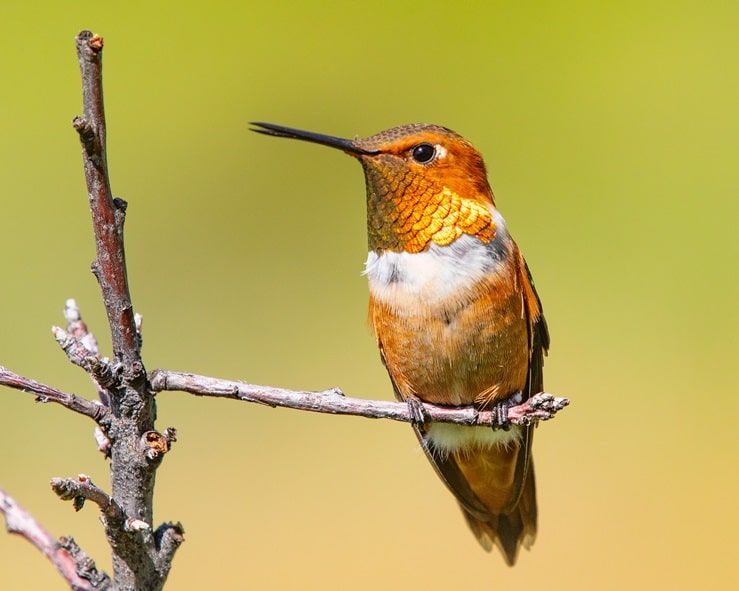
- Scientific name: Selasphorus rufus
- Size: 2.8-3.5 inches long
- Weight: 0.1-.02 ounces
- Wingspan: 4.3 inches
Rufous means “reddish” and that’s what these birds are. When the sunlight hits them, they glow like a lump of burning coal, with a reddish back and a vivid red throat. The females have a little bit of green on their tails and flanks, plus a little spot of orange on their throats.
Even though these birds might just be visiting an area as they migrate, they’re fierce defenders of the area they are in. They will tirelessly chase off any hummingbird that dares come near. They’ll even chase off bigger birds of other species and they’ll dive-bomb humans who come too close to their feeder or nest.
Like ruby-throated hummingbirds, they’re incredibly agile and will feed from feeders and tubular flowers, as well as snatch insects from the air or spider webs. They live in backyards, forests, meadows, and parks.
In the spring, they leave to their breeding grounds on the west coast where they stay from April to July.
When Do They Arrive In and Leave Michigan?
These hummingbirds aren’t common in Michigan. They arrive in the state during the summer, if they come at all. There have only been two dozen or so recorded sightings.
5. Mexican Violetear
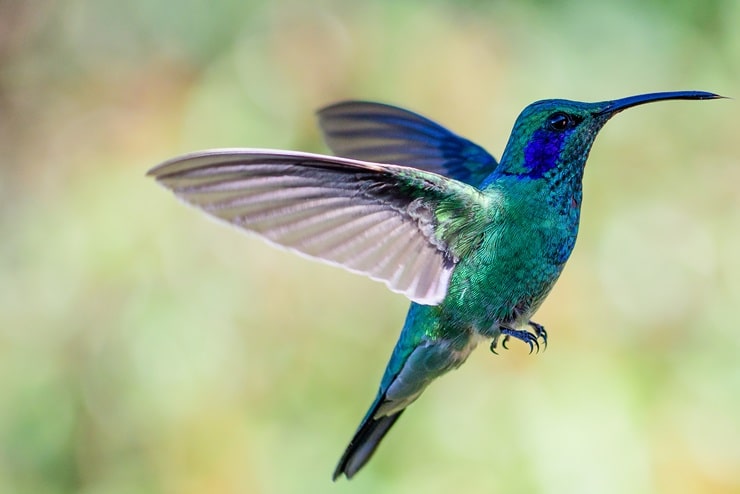
- Scientific name: Colibri thalassinus
- Size: 5.25 inches long
- Weight: 0.21 ounces
- Wingspan: 4.25 inches
Formerly known as the green violet-eared hummingbird, these are large for hummingbirds and can be nearly five-and-a-half inches long. Combined with their bright green bodies and violet streaks on the chest and cheeks, it’s easy to spot them as they flit about pine forests and roadsides.
They will visit birdfeeders, but they like to stay hidden as they eat, so if your feeder is out in the open they might not hang out much.
Their populations are concentrated in the southwest US and all of Mexico down through parts of Central America, but these birds are wanderers. You’ll find them as far north as Canada and occasionally across the midwest and Atlantic Coast.
When they pop up in states like Michigan, it’s known as an “accidental” visit. It doesn’t mean that the bird didn’t know where it’s going, though. It’s just a term that birders use to describe a species that visits an area where they aren’t normally seen.
When Do They Arrive In and Leave Michigan?
There’s no telling when you might see a Mexican violetear, but watch for them primarily during the summer. There have been more than three sightings in Michigan, but fewer than 30, so this is a casual visitor.
6. Broad-Billed Hummingbird
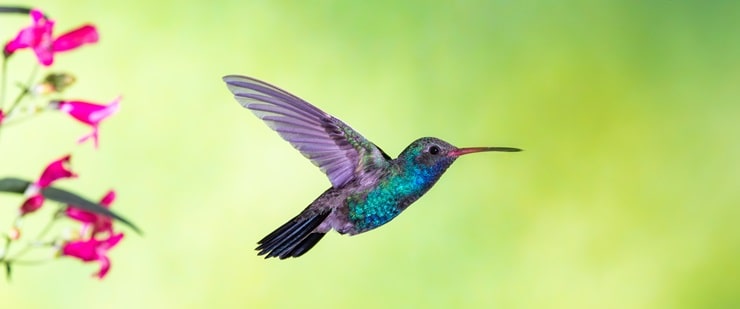
- Scientific name: Cynanthus latirostris
- Size: 3.5 inches long
- Weight: 0.1 ounces
- Wingspan: 4.3 inches
The broad-billed hummingbird makes Mexico and a few parts of the Southern US such as Arizona and New Mexico its home. It stays year-round in Mexico, but ventures further north during the breeding season.
This bird has a long, narrow, straight bill and a tail with a notch at the center, which helps you tell it apart from other species. They also stand out because of their shimmering green bodies and blue throats on the males. The bills are red with a black tip.
They eat insects as well as nectar from flowers and feeders.
These birds create their nests in mountain canyons and then head to higher elevations to forage after raising their young. The males court the females with a swooping display that has been compared to the swinging of a hypnotist’s watch.
There are five sub-species but only the magicus sub-species lives in the US.
When Do They Arrive In and Leave Michigan?
Look for them in the summer, though they’ve only been recorded in Michigan twice.
7. Costa’s Hummingbird
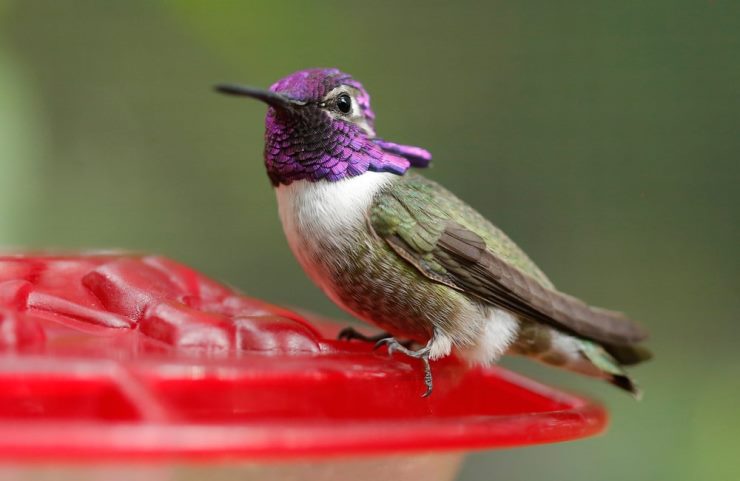
- Scientific name: Calypte costae
- Size: 3.5 inches long
- Weight: 0.1 ounces
- Wingspan: 4.3 inches
These compact little birds appear to have a sort of hunched posture. The adult males have a purple crown and neck, with a green back and sides.
These birds feed on chuparosa and ocotillo, as well as insects and at feeders. They live in desert areas of the American west. You mostly find them in Southern California, Nevada, parts of Utah, and a little bit of New Mexico, but they do migrate so you might see them as far east as Florida and as far north as Alaska.
They breed in the interior of the country but stay on the coast year-round. During the non-breeding season, some might visit coastal Mexico.
These birds are shyer and will avoid feeders if bolder, more aggressive species are there.
When Do They Arrive In and Leave Michigan?
To be perfectly honest, if you spot one of these birds you’ll be eligible for the record books. There is only one official sighting of a Costa’s hummingbird in Michigan, which took place in 2014, according to the Michigan Bird Records Committee.
8. White-Eared Hummingbird
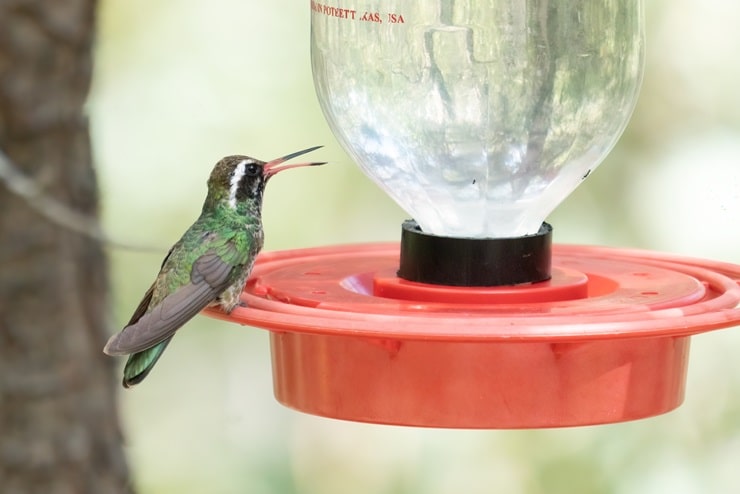
- Scientific name: Hylocharis leucotis
- Size: 3.75 inches long
- Weight: 0.12 ounces
- Wingspan: 4 inches
These hummingbirds are easy to distinguish from other species because both the males and females have a white ear stripe. The males are emerald green with a purple crown and a blue-green chin. Their bills are red with a black tip. Females, on the other hand, are green with black breasts, and green streaks on their sides.
While they generally stick to their native home in the mountains of Mexico, they will venture north to Texas, New Mexico, Arizona, and Mississippi. They eat insects and the nectar from tubular flowers.
When Do They Arrive In and Leave Michigan?
White-eared hummingbirds might visit Michigan during the breeding season of early spring. There have only been a few sightings, most recently in 2005.
9. Berylline Hummingbird
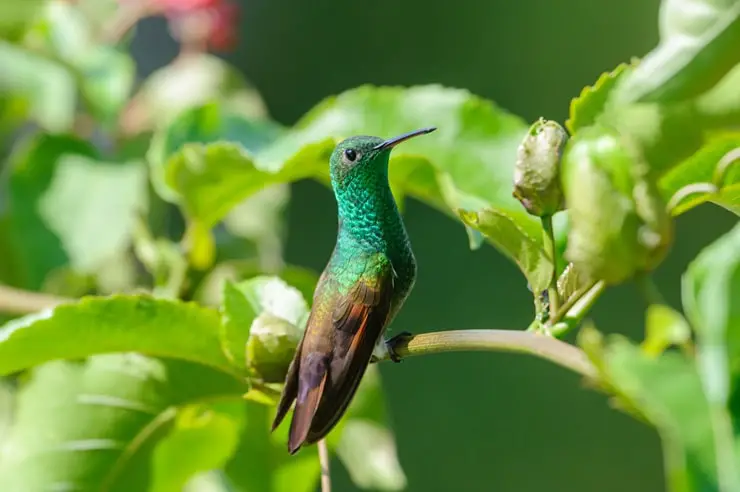
- Scientific name: Saucerottia beryllina
- Size: 4.3 inches long
- Weight: 0.12 ounces
- Wingspan: 5.9 inches
Flitting through the uplands of Mexico and the southern parts of New Mexico, Arizona and Texas near the border are the beautiful berylline hummingbirds. These aggressive birds love to dine on sugar water at feeders, as well as on the nectar of flowers and flying insects.
They’re primarily emerald green with a rust-colored wing patch and belly. Both sexes have a little red patch on their lower bill, but the females are duller in color.
When Do They Arrive In and Leave Michigan?
These birds rarely breed north of the border in the US, so look for them primarily during the late winter and early spring. They’re even less common in Michigan, and have only been recorded a handful of times, including most recently in 2014.
How to Attract Hummingbirds
To attract hummingbirds to your yard, pick feeders that have a little perch so you can observe them holding still as well as in flight.
Contrary to common belief, the feeder doesn’t have to be red. These birds don’t care about the color, they just want a nice meal. You can grab a beautiful feeder with perches from Bolite. Don’t die the nectar, either. Clear nectar is totally fine.
You can also use pre-made nectar to attract them. Just be sure to change the nectar frequently and wash the feeder out with hot water and soap. When it’s really hot, you should change your feeder daily. During cooler weather, once a week is fine.
Feeders left uncleaned develop a mold that can kill hummingbirds.
You should also plant stuff like firebush, fuchsia, honeysuckle, trumpet vine, and powder puff trees. Hummingbirds love these.
Other Species of Birds in Michigan:
Woodpeckers in Michigan
Owls in Michigan
Vultures in Michigan

Very informative.
I seen a bird at one of our feeders this morning that was definitely not a Ruby Throat. I will keep my camera handy. Nunica, Mi (8-4-23).